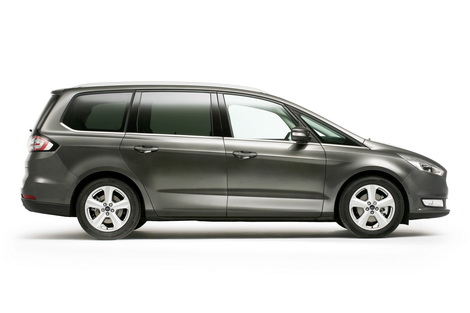Following in the wheel tracks of the recently revealed new S-Max, Ford has unveiled its all-new seven-seat Galaxy. Ford's designers have applied the latest Ford style to the larger people carrier while its engineers have worked to improve the levels of refinement. It will also feature lots of technology not only to make driving safer but also easier.
Exterior
Being a full-sized seven-seater the Galaxy is somewhat limited as to the silhouette it can take but Ford's designers have given it many of the familiar details we now see throughout the current model range. The front of the new Galaxy features Ford's distinctive grille and sleek headlight units that are angled to draw the eye up along the higher beltline of the car.
Thin pillars and a high roofline help to maximise the glazed areas helping to add light and a greater sense of space to the interior while also providing passengers with a better view of the world passing by. There will also be the option of a full-length retractable panoramic glass roof. The rear of the car looks smart thanks to the clever incorporation of the lights into the glass of the tailgate.
Interior
From the driver's seat, the dashboard layout is a simple one comprising mainly of a detailed instrument cluster and a large colour touchscreen in the centre console to handle much of the infotainment and auxiliary controls. Buyers will be able to order an optional 10-inch digital unit in place of the traditional instrument dials and this will enable more detailed displays with 3D graphics to boot.
All three rows of seats are claimed to offer good levels of head- and legroom, while comfort has been improved across the board. Improvements have also been made to elbow- and shoulder room for passengers in the second row. Access to the third row of seats has been made easier by second-row seats that tilt and slide forward in a single movement while the recessed floor adds a further degree of ease when entering or exiting the car. Third row occupants now also get their own arm rests.
Boot space can be easily increased from the rear by a control panel that gives the function to fold down some or all of the seats with the press of a button. Even more useful is a new function, one that Ford claims to be a segment-first, which automatically raises the third row of seats for use.
Mechanicals
The new Galaxy has utilised the integral link rear suspension from the new Mondeo and S-Max to help give it a more refined ride. This system enables the car better absorb impacts by allowing the wheels to move further rearwards over bumps without having any noticeable impact on handling - so Ford claims. There are also increased levels of sound insulation in the underbody, doors and wheel arch linings.
The engine line-up for the new Galaxy will consist of 120-, 150- and 180hp versions of its 2.0-litre TDCi diesel engine along with a new 210hp TDCi bi-turbo diesel engine. On the petrol front, 160hp 1.5-litre and 240hp 2.0-litre EcoBoost engines will be available to order. These petrol engines will also feature stop-start and a system called Smart Regenerative Charging, which reduces fuel consumption by engaging the alternator to charge the car's battery when the vehicle is coasting and braking.
Anything else?
Ford will offer a number of safety and convenience-related systems on the new Galaxy such as an Adaptive Front Lighting System that adjusts the height of the beam depending on the driving environment and can prevent dazzling on-coming drivers. Parking could be made easier too with a number of new systems aimed at helping the driver. Perpendicular Parking can detect a free space and reverse the car in without the need for any steering input from the driver, while Park-Out Assist can then help the driver move out of a parallel parking space should some other driver have blocked you in to a tight space.





